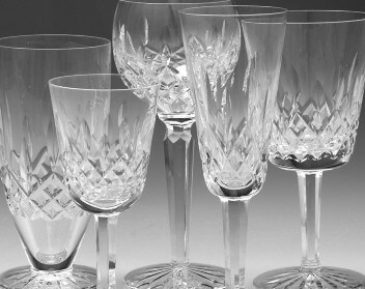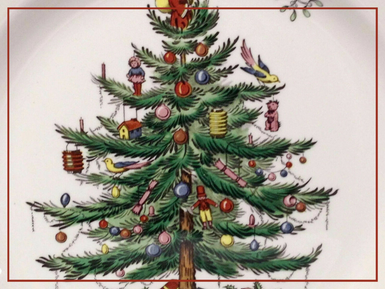Waterford Crystal Stemware
So, you’re thinking about downsizing and you’re not sure what to do with your formal table setting of china, silver, and crystal? Good news! There is a busy resale market for these items. Estate Sale expert Daniel Sanders with Four Sales in the Washington DC area gives us the inside scoop on Waterford Crystal stemware.
While times have changed and formal dining is less a part of daily life, it is almost certain that, at some point, most people have gathered for the holidays and found the holiday table to be set with fine china, silver flatware, and accessories, and crystal stemware. The sparkliest part of these functional decorations was almost certainly the lead crystal stemware that refracts light throughout the room and adds to the festive atmosphere through both light and sound.
What is Lead Crystal?
As we know from archaeological remnants found in Mesopotamia, glass with a lead content has existed since about 1400BC. It is only since the 17th century that lead crystal has served to beautify homes and dinner tables by adding elegance and beauty. Lead crystal was developed in England by George Ravenscroft in 1675 and made use of lead as an abundant raw material. While glass stemware can be made using metal oxides other than lead oxide, these are referred to as crystalline or crystal glass. Glass made with at least 24% of lead oxide is what is commonly referred to as lead crystal.
The shapes and patterns have changed over time to match the decorating trends of the period, but the basic shapes have remained the same. The structure of crystal stemware consists of a rimmed bowl perched on a thin stem and supported and given balance by a foot. The bowl, stem, and foot may have different patterns produced by molding, cutting, etching, or occasionally a transfer appliqué.
Famous Makers of Lead Crystal Stemware
There are many, many, manufacturers of lead crystal stemware, a few of which have become household names. These famous companies include Waterford, Baccarat, Orrefors, Daum, Nachtmann, and St Louis. Other manufacturers, although they are better known for china, like Noritake and Lenox, have also produced or branded lead crystal stemware products. However the most well-known of these companies is, without question, Waterford Crystal.
Waterford Crystal was produced in Waterford Ireland starting in 1783 when George and William Penrose started their business. The company operated until 1851 and then was closed until it reopened in the early 1950s. In addition to stemware, the company makes all manner of vessels and containers from biscuit jars to ring holders to bowls and more. Although the name is firmly tied to the company’s origins in Ireland, their products are now produced outside Ireland in countries like the Czech Republic, Slovenia, Hungary, and Germany.
Marquis by Waterford
It has been interesting to see a company like Waterford Crystal (officially WWRD Holdings Ltd owned by the Fiskars Corporation) change and adapt in response to market trends over the past 30 years. As formality waned and demand increased for more contemporary styling, Waterford made a major shift in 1991. At that time, in addition to their traditional products, like Lismore (which remains the most ubiquitous lead crystal pattern sold by Waterford), they introduced Marquis by Waterford, which was the first new line since the company’s inception.
Unlike traditional patterns, Marquis by Waterford is an affordable quality crystalline glass. The glasses are well‐weighted, and the patterns are more contemporary than its lead crystal cousins. Marquis by Waterford also pursued a more omni‐present retail channel and is actively sold through big box retailers like Marshalls, TJ Maxx, Ross for Less, etc. It could be argued that the shift to provide a more affordable product impacted the value of Waterford crystal product sales, since the average consumer draws little distinction between the classic Waterford products and the Marquis products. Additionally, the nature of the selected distribution channels lends itself to lower prices with an average resale price of $10‐15 per glass.
How Do You Know It’s Waterford?
Authentic Waterford Crystal stemware will most commonly have an acid stamp in Gothic script on the foot of a glass that says “Waterford”. New or like-new pieces may have a foil sticker with the seahorse. Marquis by Waterford is distinguished by a blue rectangular label or square foil label that say Marquis, or an etched watermark that says Marquis by Waterford.
See more tips on identifying Waterford Crystal Here.
So, What’s It Worth?
As with just about everything we discuss in our “What’s It Worth?” column, the value of Waterford Crystal stemware is different depending on where you buy it!
Retail stores may price a new Waterford lead crystal Lismore wine glass at about $80‐$90 per stem. However, a recent search on Ebay shows that a set of two “Lismore” wine goblets went for $39 in September 2021.
Our advice? Because of the weight and fragile nature of Waterford Crystal Stemware, we recommend getting in touch with a local auction house or estate sale specialist in your town for the most up-to-date information about the value of your Waterford Crystal Stemware.
Daniel Sanders is the owner of Four Sales Estate Sales, serving the Washington DC area.








